It is one of the ironies of the history of science that Galileo’s most important and most solid piece of science writing[1], his Discorsi e dimostrazioni matematiche intorno a due nuove scienze (Discourses and Mathematical Demonstrations Relating to Two New Sciences) was published almost at the end of his life, when the research that he carried out, on which it was based, took place in his younger years, in the late 1590s and early 1600s.
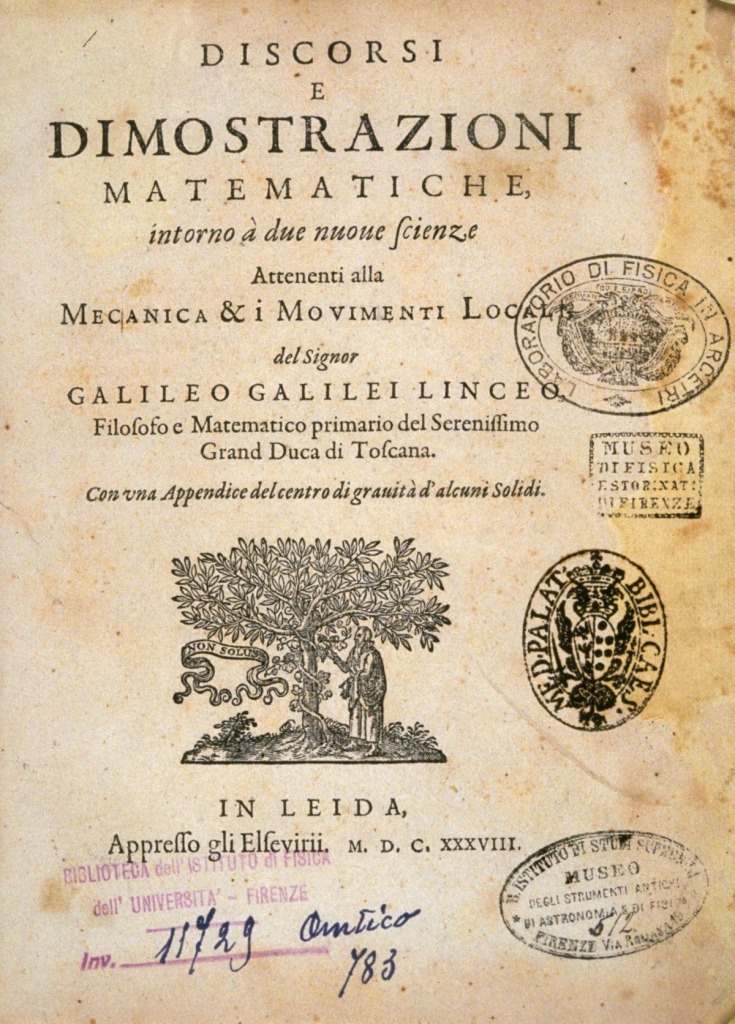
His initial interest in dynamics began in Pisa between 1589 and 1592 during his first appointment as a very insignificant professor of mathematics hired to teach Euclid as a sort of proof theory to philosophy students and astrology to medical students.
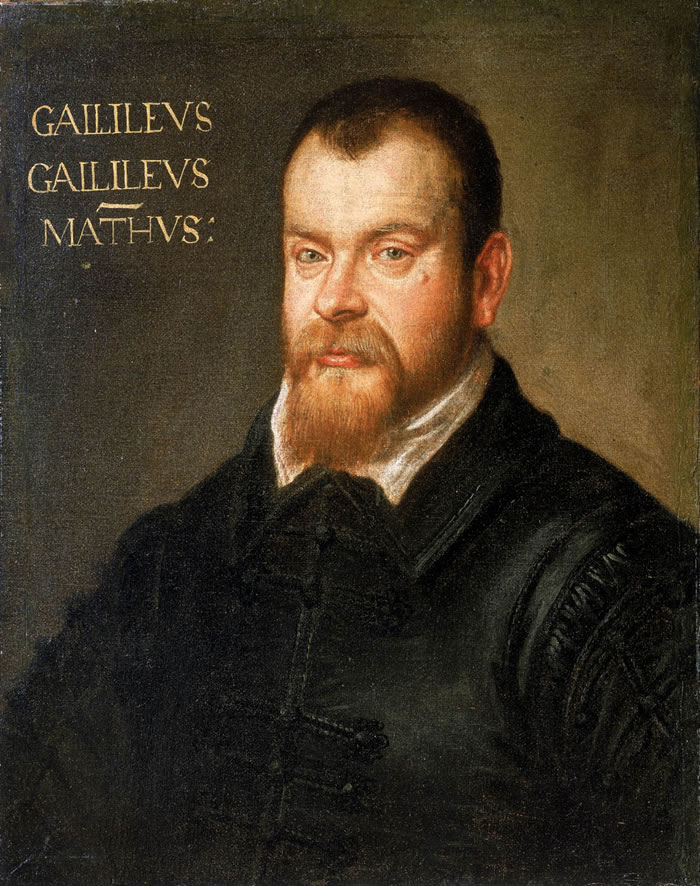
During this early phase his work consisted of philosophical speculation and contained none of the mathematical analysis or experiments for which he became famous. His thoughts on mechanics from this period, which were in his lifetime never published[2] and don’t appear to have been in anyway circulated as manuscripts, have survived as a single collective manuscript, De motu antiquiora. It is not known who bundled the contents of De motu together, or who gave it this name.
De motu actually consists of four separate pieces of work, a dialogue on motion (D), a ten chapter essay (E10), a twenty-three chapter essay (E23), and a rewrite of the first two chapters of E23 (E2).[3] Internal evidence strongly suggest that the texts were written in the order D, E23, E2, E10. Most sources suggest that none of the text is complete but Meli thinks E23 is.
The dialogue is between Alessandro (Galileo), and Domenico (thought to be the Platonic philosopher Jacopo Mazzoni (1548–1598)), as in all Galileo’s dialogues the stooge, who gets convinced that Galileo is right. Domenico starts from De motu gravium et levium (1575) of Girolamo Borro (1512–1592), who had probably been one of Galileo’s teachers in his time as a student in Pisa, and wishes to discuss six questions:
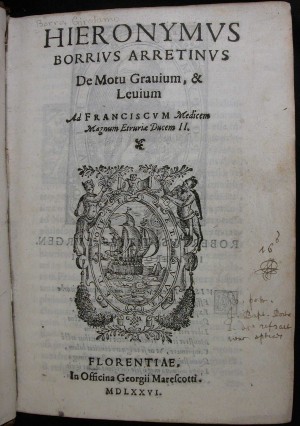
- Whether there is rest at the turning point of motion.
- Why, when two bodies of the same size but different materials, such as wood and iron, are dropped from a height, the light moves more swiftly than the heavier, if this truly does happen.
- Why natural motion continuously becomes swifter while forced motion continuously slows down.
- Why bodies fall more swiftly in air than in water.
- Why cannonballs travel farther when the cannon is fired at right angles to the horizon (vertically) than when fired parallel to it (horizontally).
- Why heavier balls shot from a cannon travel more swiftly that lighter ones, even though the latter are easier to move.
During the dialogue, which is almost certainly not complete, Alessandro (Galileo) devote considerable energy to answering questions 4, 1, and 3 in that order.
Obviously unhappy with the way the dialogue was developing, Galileo abandoned it in an obviously unfinished state and wrote instead the twenty-three chapter essay. This addresses the same question but extends the scope of the discussion into the area of statics and mechanics in the sense of the five simple machines.
In all of this work we have to consider Galileo’s situation. He is still a relatively young man, in his late twenties, lacking a university degree himself but employed as the lowliest and worst paid professor[4] at a thoroughly Aristotelian university. As noted in the last post in this series the two dominant professors of philosophy in Pisa were both strident Aristotelians, Girolamo Borro (1512–1592) an adherent Averroes interpretation of Aristotle and his aggressive opponent Francesco Buonamici (1533–1603), who insisted on a pure Greek interpretation of Aristotle. Galileo received lecture notes from the Jesuits of the Collegio Romano, who were, of course, strict Thomists, to assist him in his first teaching endeavours.
This is not the infamous, strident anti-Aristotelian warrior of his later years but an unknown scholar still half-trapped in an Aristotelian corset, who is setting out to criticise and replace Aristotle’s theories of motion, fall and projectile motion. Something, that others had been striving to do since, at the latest, John Philoponus in the sixth century CE.
I’m not going to give a blow by blow detailed account of Galileo’s thoughts and ideas as expressed in the dialogue and essay contained in De motu but merely pick out a few salient points.
Firstly and fundamentally, Galileo rejects Aristotle’s dichotomy between gravitas and levitas. A theory that attributed the property to either fall, gravitas, or rise, levitas, to all material bodies. For Galileo there is only gravitas, the tendency to fall that varies from body to body, sometimes more sometimes less. He also, like many others, rejects Aristotle’s theory of fall , which says that the rate of fall of an object in a medium in is directly proportional to their weight and inversely proportional to the density of the medium. For Galileo the rate of fall of a body through a fluid medium is directly proportional to the arithmetical difference between the specific weight (gravitas in specie) of the body and the specific weight of the fluid. This is an application of Archimedes’ hydrostatics to the theory of fall. A natural consequence for Galileo is that bodies have a rate of fall in a vacuum, i.e. when the arithmetical difference is zero, contradicting Aristotle’s argument that the rate of fall in a vacuum would be infinite therefore a vacuum cannot exist.
In the eighth section of the essay, Galileo discusses the rates of fall of different materials in different media and what happens to those rates when you combine the materials. During this discussion brought for the first time the argument that would end up in Discorsi:
Galileo then returns to Aristotle’s claim that heavier bodies of the same material fall faster: if two bodies of the same material but different sizes (and likewise weights) fall with different speeds, then when connected together, the assumption leads us to believe that the combined bodies will have an intermediate speed; however, the combination of the two bodies will have a total weight that is greater than any of the standalone bodies. Therefore, according to Aristotle, the combined weight should fall even faster than either of the standalone bodies, which leads to self-contradiction. The only way to correct the contradiction is to reject Aristotle’s claim and assume that the two bodies of same material but different size (and weight) fall at the same speeds. (Wikipedia)
One aspect of Galileo’s theory of fall at this time is that he regarded uniform speed and not uniform acceleration to be the norm for a falling body. The observed acceleration was perturbation caused by impressed force, (virtus impressa) that was generated by the force holding the body in equilibrium before the fall–for example the hand holding it up. This appears to be the same as or at least similar to the impetus theory, which raises the question of Galileo’s source for such a theory. Most likely he had it from the work of Borro, with which he was well acquainted, because Borro discusses the theories of Ibn Bājja, known to Borro and Galileo as Avempace, against which Averroes had argued.
In the essay Galileo turns to discussion of motion in terms of statics and the five simple machine, a hot topic in the sixteenth century especially for Galileo’s earliest patron Guidobaldo del Monte (1545–1607), a topic I will deal with in a later episode. Galileo first turns his attention to motion respective the balance, which I’m not going to discuss here. Later he considers motion on an inclined plane, which is interesting given his later series of experiments to prove the laws of fall using one.
Galileo initially addressed the question, why a heavy body falls more swiftly along a steeper inclined plane than on a less steep one. He moves on to consider the case of the force required to move a body on a horizonal plane. He argued that if the plane and a ball were very smooth and perfectly hard then it would require very little force to set the ball in motion and, “indeed by a force less than any given force.” Galileo conceptualised this motion as parallel to the horizon, so in theory the ball would circle the earth and not sheer off at a tangent. One can sense Galileo’s theory of circular inertia emerging in these thoughts. He also goes on to consider the case of constructing a plane with an inclination such that two bodies of equal size and different materials would fall along it and down the vertical in equal times. Here he is already formulating the famous inclined plane experiments that would later form the core of the Discorsi.
The essay closes with a discussion of projectile motions, where Galileo’s theories are very close to those of Tartaglia, which should not come as a surprise as Galileo’s the man who taught Galileo mathematics in Florence, Ostilio Rici (1540–1603), had been a student of Tartaglia.
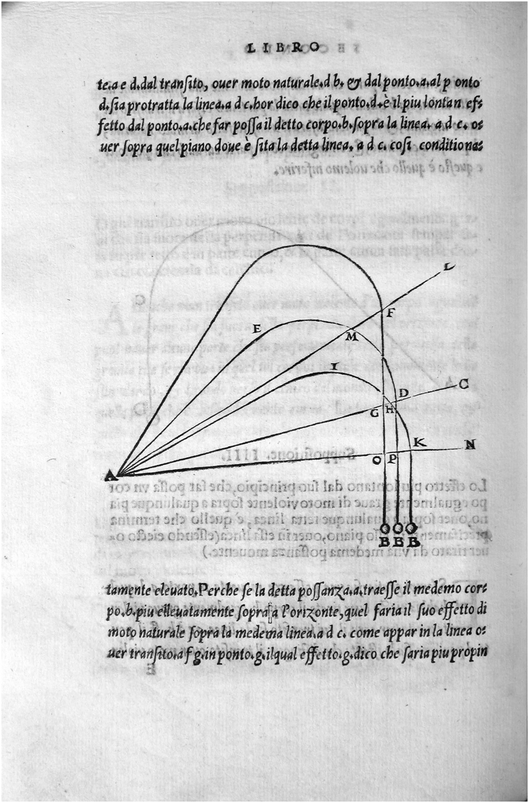
The strong similarity between the theories that Galileo propagates in De motu and those propagated by Girolamo Benedetti in his various publications immediately poses the question, was Galileo parroting Benedetti or even plagiarising him? There appears to be little hard evidence and historians have divided opinion of the relationship between Galileo’s work and that of Benedetti. However, the majority opinion is that Galileo had no knowledge of Benedetti’s work at the time he wrote the various manuscripts contained in his De motu.
The main argument is that although Galileo mentions both Borro and Buonamici in his writings at this time, he makes absolutely no mention of Benedetti. Some argue, unconvincingly, that Benedetti’s work was unknown in general, so it’s not surprising that Galileo had never read it. If Benedetti’s work was unknown how come the Wallonian musician, mathematician and astrologer, Jean Taisnier (1508–1562), plagiarised the 1stedition of Benedetti’s Demonstratio in 1562. A plagiarism that Simon Stevin quoted in 1586 and Richard Eden (c. 1520–1577) translated into English in 1579.
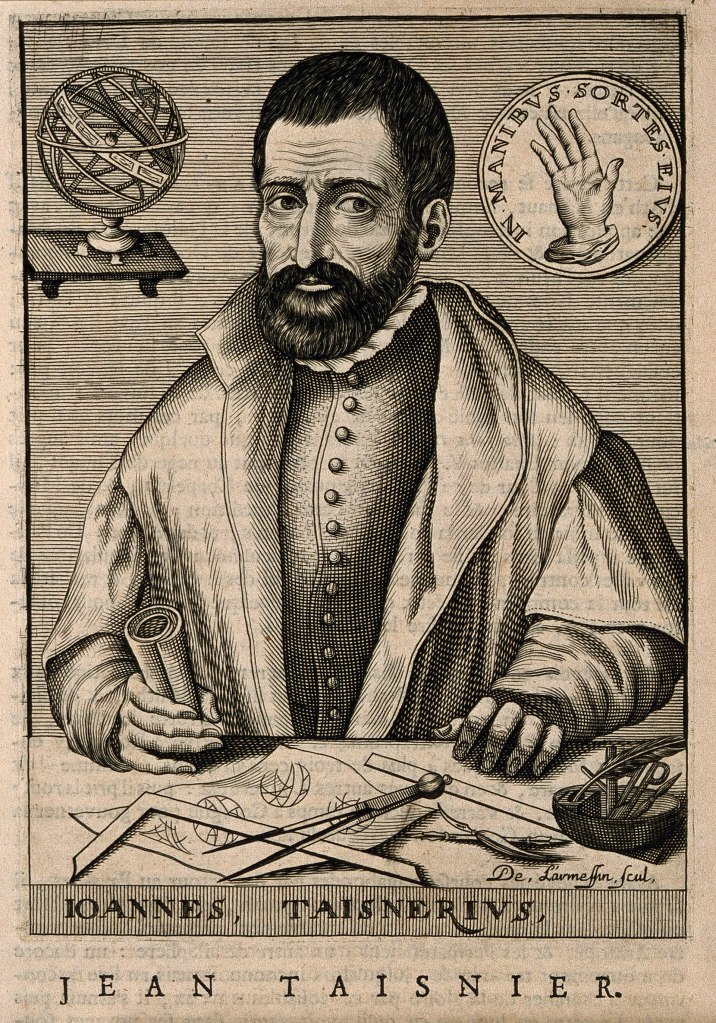
The strangest argument is that because Benedetti’s work was published in Venice it wouldn’t have been known in Pisa, where Galileo was working at the time. This argument is particularly bizarre because Galileo’s friend and colleague in Pisa, Jacopo Mazzoni, wrote a philosophical treatise , Praeludia, comparing the philosophies of Aristotle and Plato, of which Galileo owned a copy, which on the subject of motion often quotes Benedetti’s Diversarum speculationum mathematicarum, et physicarum, liber. This cannot be viewed as the potential source for Galileo borrowing from Benedetti, as it was first published in 1597, long after Galileo had abandoned De motu and moved to Padua.
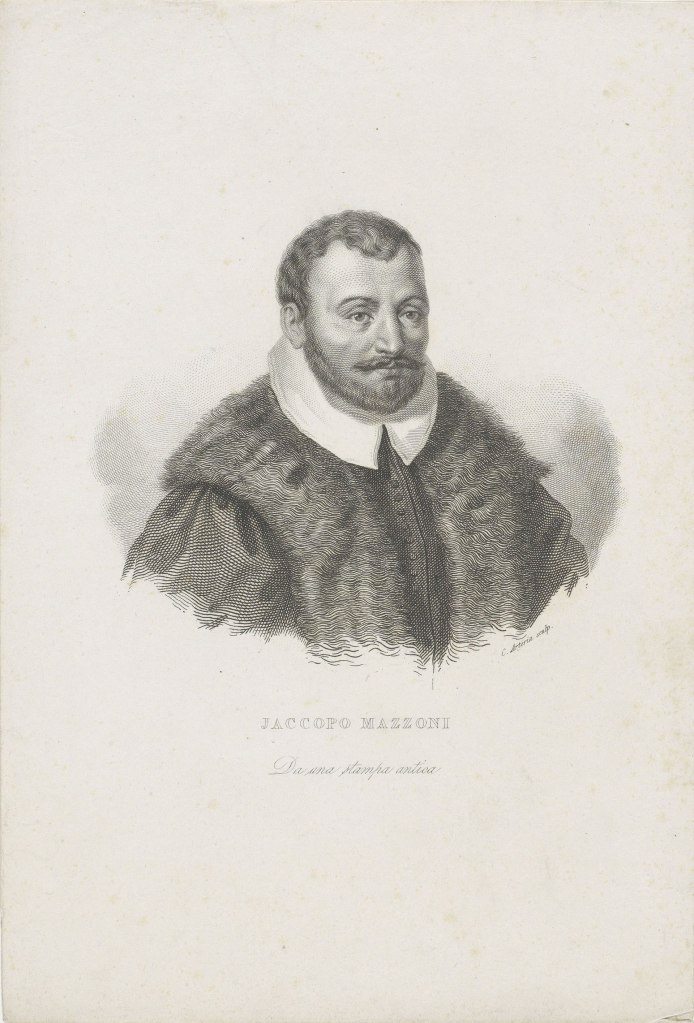
One final, interesting thesis is that Galileo wrote De motu unaware of Benedetti’s work and then somebody on reading his manuscripts pointed out to him that Benedetti had already formulated and published a very similar theory of motion forty years earlier. This revelation leading to Galileo abandoning his work on De motu.
Whatever the case maybe respective Galileo’s knowledge, or lack of it, of Benedetti’s work on the theory of motion, what we see, in the various manuscripts of De motu, is a young Galileo groping his way towards his own ant-Aristotelian theories of motion, an aim that he would first realise in the famous inclined plane experiments he conducted after he had moved to Padua and which he first wrote up and published in his Discorsi almost at the end of his life,
[1] Lagrange agrees with me on this ‘Galileo made first this important step forward [the law of free fall and the parabolic trajectory of projectiles], disclosing therefore a new and vast pathway for the advancement of mechanics. These discoveries are exposed and developed in the work entitled: Dialoghi delle Scienze nuove, etc., appeared for the first time in Leiden in 1637; they did not give Galileo, while still alive, the same celebrity that his discoveries on the system of the world gave to him, but nowadays they represent the most solid and real part of the glory of this great man.’’ Joseph-Louis de Lagrange, Me ́canique Analytique, 2 vols. (1788; Paris: Courcier, 1811), 158–59
As did both Newton & Leibnitz
[2] De motu first appeared in print in 1890
[3] The letter-number labels for the four texts are taken from Domenic Bertoloni Meli. Thinking with Objects: The Transformation of Mechanics in the Seventeenth Century, Johns Hopkins University Press, 2006, pp. 50-65, the main, but not the only, source for this post .
[4] As I like to quip, the cleaning staff had a higher status and were better paid than a professor for mathematics at a late medieval university.